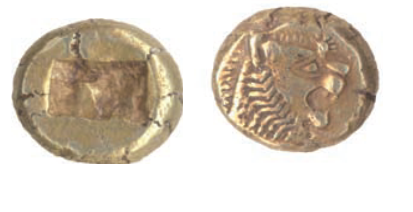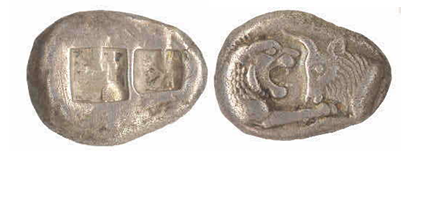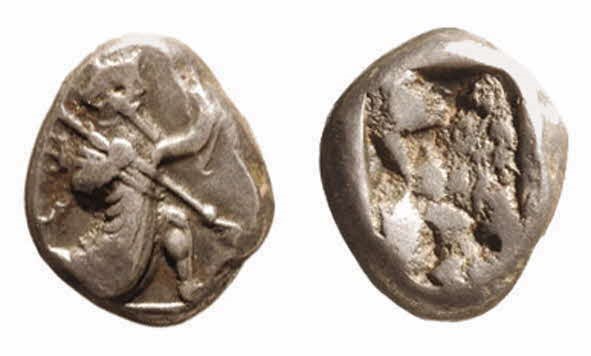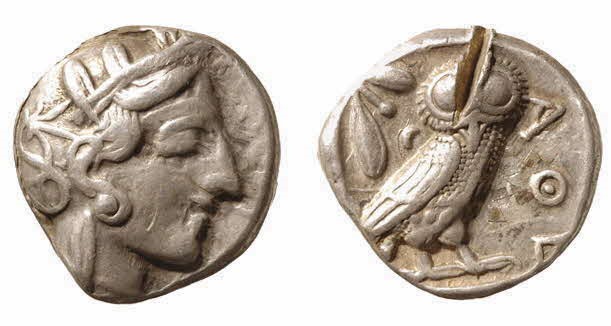Part 2 – Currency Exhibition
Part 2 – Innovation of currency and the first coins in the world.
Currency – means of payment and symbol of sovereignty
One of the current means of payment, and the main one in ancient times, is the coin. The use of coins, which originated in the seventh century BCE, was a revolutionary invention, which freed economic activity from the complexity of weighing and authenticating precious metals in each and every transaction.
As the use of coinage gained traction, it became a clear expression of sovereignty. Most ancient Jewish coins were minted during periods of Jewish independence in the Land of Israel, or during times of revolt against foreign occupiers. The coins of the State of Israel, which are first and foremost meant to fulfill an economic role, also bear a national historical message—a reflection of the independence of the Jewish nation. It was therefore decided that from the State of Israel’s first coin onward, Israeli coins would bear designs taken from ancient Jewish coins (or other ancient Jewish artifacts). This idea is unique to the State of Israel, reflecting the continuation of Jewish minting in the Land of Israel over the course of history and the Jewish nation’s attachment to the Land of Israel.
Coins are also a way of sharing ideas and memorializing events. The themes that have adorned coins throughout the ages are a source for recognizing customs, symbols, religious rites, structures, personalities, and historical events. The exhibit at the Bank of Israel Visitors Center is based on items from the Bank’s rich collection.
The introduction of currency and the first coins in the world:
The first coins in the world appeared in Lydia, Asia Minor (now Turkey) in around 650 BCE. They were made of electrom, an alloy of gold and silver, and bore a significant design on only one side. They were minted by local rulers who were descended from King Gyges, and became a symbol of the regime. As such, they served as a guarantee of the value and quality of the precious metals they contained. The coins were minted in different denominations with a weight that was as fixed as possible, thereby doing away with the complex need of weighing metals for each transaction, as had been done until then.
Until the mid-6th century BCE, electrom was the only metal used for coins, and its rarity outside of Lydia limited the minting and use of coins to western Asia Minor.
Currency – means of payment and symbol of sovereignty
One of the current means of payment, and the main one in ancient times, is the coin. The use of coins, which originated in the seventh century BCE, was a revolutionary invention, which freed economic activity from the complexity of weighing and authenticating precious metals in each and every transaction.
As the use of coinage gained traction, it became a clear expression of sovereignty. Most ancient Jewish coins were minted during periods of Jewish independence in the Land of Israel, or during times of revolt against foreign occupiers. The coins of the State of Israel, which are first and foremost meant to fulfill an economic role, also bear a national historical message—a reflection of the independence of the Jewish nation. It was therefore decided that from the State of Israel’s first coin onward, Israeli coins would bear designs taken from ancient Jewish coins (or other ancient Jewish artifacts). This idea is unique to the State of Israel, reflecting the continuation of Jewish minting in the Land of Israel over the course of history and the Jewish nation’s attachment to the Land of Israel.
Coins are also a way of sharing ideas and memorializing events. The themes that have adorned coins throughout the ages are a source for recognizing customs, symbols, religious rites, structures, personalities, and historical events. The exhibit at the Bank of Israel Visitors Center is based on items from the Bank’s rich collection.
The introduction of currency and the first coins in the world:
The first coins in the world appeared in Lydia, Asia Minor (now Turkey) in around 650 BCE. They were made of electrom, an alloy of gold and silver, and bore a significant design on only one side. They were minted by local rulers who were descended from King Gyges, and became a symbol of the regime. As such, they served as a guarantee of the value and quality of the precious metals they contained. The coins were minted in different denominations with a weight that was as fixed as possible, thereby doing away with the complex need of weighing metals for each transaction, as had been done until then.
Until the mid-6th century BCE, electrom was the only metal used for coins, and its rarity outside of Lydia limited the minting and use of coins to western Asia Minor.
Introduction of coins – Ancient kingdom of Lydia (7th century BCE)
Electrom coins – the first coins in the world
Pictured: An electrom coin (around 650 BCE)) with a lion’s head on the obverse and an imprinted rectangle on the reverse with no other design
Pictured: An electrom coin (around 650 BCE)) with a lion’s head on the obverse and an imprinted rectangle on the reverse with no other design

6th century BCE
The first silver coins
Herodotus, the famous Greek historian, attributed the invention of gold and silver coins to the people of Lydia.
This important innovation (the invention of coins made of gold and silver separately) was attributed to Croesus, the last king of Lydia, who ruled from 560-546 BCE.
This innovation accelerated the natural spread of coinage and its use throughout the ancient world, since it enabled regions with rich deposits of silver but no source of gold to mint coins of their own.
Pictured: A silver coin of King Croesus (c. 550 BCE).
Herodotus, the famous Greek historian, attributed the invention of gold and silver coins to the people of Lydia.
This important innovation (the invention of coins made of gold and silver separately) was attributed to Croesus, the last king of Lydia, who ruled from 560-546 BCE.
This innovation accelerated the natural spread of coinage and its use throughout the ancient world, since it enabled regions with rich deposits of silver but no source of gold to mint coins of their own.
Pictured: A silver coin of King Croesus (c. 550 BCE).

Persia, 5th century BCE
Upper picture:
A Persian siglos, c. 450 BCE.
Obverse: the Persian king bowing to the right and holding a bow and a spear.
This silver coin is called a “siglos” in Persian, meaning “pound”. Archaeological evidence suggests that Persian coins were not used in Israel at all.
A Persian siglos, c. 450 BCE.
Obverse: the Persian king bowing to the right and holding a bow and a spear.
This silver coin is called a “siglos” in Persian, meaning “pound”. Archaeological evidence suggests that Persian coins were not used in Israel at all.

Lower picture:
A Persian siglos, c. 400 BCE.
Obverse: the Persian king bowing to the right and drawing a bow.
This silver coin is called a “siglos” in Persian, meaning “pound”. Archaeological evidence suggests that Persian coins were not used in Israel at all.

Athens, 5th century BCE
An Athenian tetradrachma (a large silver coin). The obverse bears a design of the head of the Athenian goddess, and the reverse bears a likeness of a night owl, with an olive branch with leaves and a blossom on the upper left.
This coin type served as the “dollar of the ancient world”, and was the subject of many local imitations throughout the Greek world of the 5th and 4th centuries BCE, including in the area of Israel.
This coin type served as the “dollar of the ancient world”, and was the subject of many local imitations throughout the Greek world of the 5th and 4th centuries BCE, including in the area of Israel.
